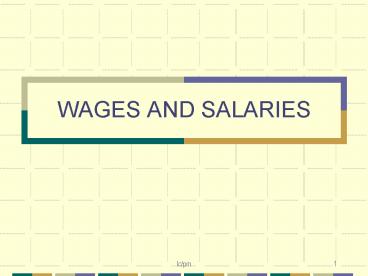WAGES AND SALARIES - PowerPoint PPT Presentation
1 / 10
Title:
WAGES AND SALARIES
Description:
WAGES AND SALARIES lc/pm * lc/pm * WAGES AND SALARIES It is important that employees are properly rewarded for the work they do. Employers Objectives Employees ... – PowerPoint PPT presentation
Number of Views:210
Avg rating:3.0/5.0
Title: WAGES AND SALARIES
1
WAGES AND SALARIES
2
WAGES AND SALARIES It is important that employees
are properly rewarded for the work they do.
Employers Objectives Employees Objectives
Motivation Purchasing power
Cost and profitability Fair pay
Prestige Comparison with others
Recruitment Recognition
Labour Turnover
Control
3
- PAYMENT SCHEMES
- There are a number of methods which can be used
to reward employees for the work they do. - Annual salaries
- Time Rates
- Piece Rates
- Commission
- Fees
- Fringe Benefits
4
- ANNUAL SALARIES
- Fixed amount agreed per year
- Hours and conditions of work laid out in
Contract of Employment - Suitable method for permanent full time staff
- Suitable for professional, management positions
5
TIME RATES Paid hourly rate, eg 5.00 per
hour Standard working week, eg, 35 hours per
week Basic pay calculated 5 x 35 hours
175 Hours worked in excess of standard pay is
OVERTIME Overtime may be at time and a half or
double time. Double time 10 Time and a half
7.50 per hour Gives guaranteed income for
employees Used where quality of work is more
important than time taken Suitable for service
sector workers
6
- PIECE RATES
- Pay is linked to output
- Agreed rate for every item produced eg 1 per
garment completed - Used as an incentive, the more a worker
produces the more they will earn - Workers usually given target to meet
- Can result in low wages
- Need for quality control to ensure goods made
are of a standard - Used in manufacturing industries
7
- COMMISSION
- Used in sales, eg insurance, telesales etc
- Some or all of employees earnings are based on
the amount of sales they make eg, 10 commission
paid on monthly sales total of 10,000
commission of 1,000 - Used as an incentive to work hard and as a
reward - Wages can fluctuate greatly from month to month
depending on sales
8
- FEES
- Payment for oneoff tasks
- Tasks geared towards needs of clients
- Amount paid will depend on time taken and
difficulty of task - Examples
- Solicitors
- Performers
9
- FRINGE BENEFITS
- Payments other than wages or salaries
- Often made to executive, management and
professionals - Some benefits are subject to tax
- Have grown in importance, gives status to
people - Examples
- Private medical insurance
- Company car
- Free transport
- Subsidised meals
10
DEDUCTIONS No matter which method of payment is
used to calculate GROSS PAY, deductions are then
made to give NET PAY (take home pay) GROSS PAY
less DEDUCTIONS NET PAY
STATUTORY DEDUCTIONS VOLUNTARY DEDUCTIONS
Income Tax Union Dues
National Insurance Pensions and Savings schemes

